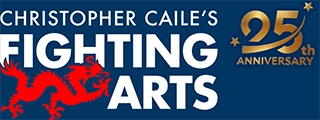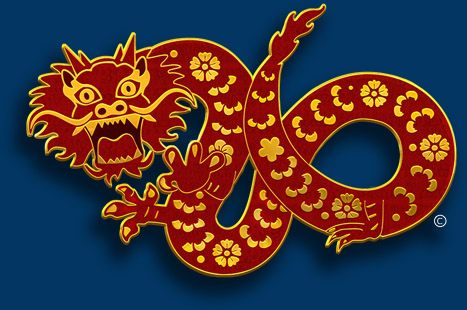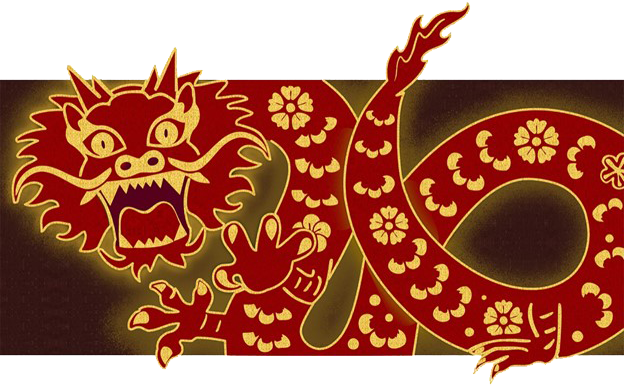The Straight Arm Double Lapel Grab, Part 1
by Christopher Caile
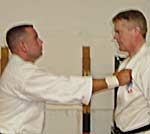
Editor's Note: This is the first of a two part series on the straight arm double lapel grab where the attacker grabs the jacket lapel or shirt on both sides, but then holds the defender at arm's length. Part 1 shows a defense to this attack taken from the karate kata Pinan number four. The second article will feature another kata's solution to the same attack. These articles complement an earlier article, "The Double Lapel Grab," which addressed the same grab, but was different in that the attacker there pulled the defender in.
You are in the middle of a heated discussion, an argument or other confrontation and suddenly the other person loses control and grabs your shirt on both sides of your chest, or the lapels of your jacket, with both hands.
Sometimes the aggressor pulls you in close (the subject of a previous article, "The Double Lapel Grab"), but just as often you are just held at arms length — a somewhat timid attack to say the least. Of course, you have to be careful of a kick, but this type of attack suggests that the aggressor is either really not sure of what to do, or that he or she has lost control but really doesn't want to get into a full fledged altercation. So, what to do? You have a lot of options.
If the attacker doesn't escalate into punching or a follow-up kick, the best initial option is to try to diffuse the situation verbally. While the attack is potentially scary, remember that the attacker is not really hurting you. He or she is also occupying his primary weapons — the hands. So, if you remain calm, often the attacker can be convinced to dislodge himself from a situation that he or she probably didn't want to escalate in the first place.
Of course, you can just relax, do nothing and wait. The attacker just might tire of his or her physical substitute for words and eventually let go. But be attentive to any possible follow-up attack.
This assumes, of course, that the two arm grab isn't just being used to immobilize you until a companion can take your head off. In the latter situation, you must react immediately.
If you must proceed I always advise to use a "continuum of force" — starting with techniques which may hurt, sting or create the release itself, but that will do no harm to the aggressor, and progressing through to being able to render the assailant unconscious, incapacitated or immobilized.
The second critical factor is that any technique should be effective, easily applied and useful for a weaker person against a stronger one.
A number years ago while teaching Seido karate at the State University of New York at Buffalo (SUNY) we found that many of the common street self-defenses we taught students either were not very effective, or didn't work well if the defender was much smaller and weaker than the aggressor. When we began examining our karate kata, however, various solutions and progressions of technique began to jump out at us. The more we looked, the more we found.
This article will illustrate self-defenses technique against the straight arm double lapel grab taken out of Pinan 4. The next article in this series will provide another solution taken from the kata Seinchin, although as you will see that the two technique series can be linked.
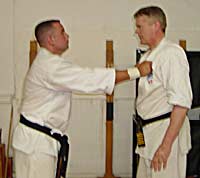
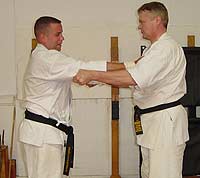
If the attacker is larger than the defender, arm's length often means that the defender can't reach far enough to counter with the arms — they are just two short to reach the head or body. But they can reach far enough to pinch the tender area under the upper arms. While painful, this counter does no real harm and many attackers will just release and jump back. See: Ouch! The Mighty Little Pinch For Self-defense.
The next step in escalation is perfectly illustrated in one series of moves from the karate kata Pinan 4. Both arms are moved inward and upward and spread in front, followed by a front kick and then a double punch middle starting with the arm opposite the kicking foot. In the kata this sequence is repeated twice. (1)
After the attacker has grabbed, the defender brings both elbows to the chest with arms close together (almost touching), and moves them up and between the attackers arms (at this point crossing) and then spreads the arms. (2)
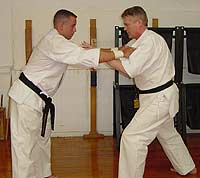
Now, pull backward (if his arms are locked this won't pull the attacker inward towards you but will momentarily lock the attacker's arms in place) while executing a front kick. This pull-kick action greatly magnifies the power in the technique.
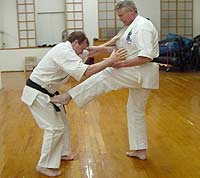
The area between the upper leg and lower abdomen (in the middle of the crease between the two) is very sensitive and not well protected by thick muscles. It is here that the femoral nerve, a major nerve of the leg, and femoral artery run together and are exposed to attack. A driving kick will force the attacker's hip backward (and head forward) while causing a lot of pain (the body's reflexive action to this strike is to withdraw).
In most cases the attacker will try to lower his arms to defend against the kick, but this will be momentarily blocked (or slowed) by the defenders hold on the arms. Here, I have let go with my left arm just after the kick has landed. Notice how close it is to the attacker's head.
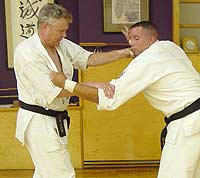
In this self-defense the primary technique is the holding of the arms and the kick. The follow-up punches are secondary. They can also vary. If the attacker doesn't let go the defender can kick again, or if one arm is let go (as demonstrated above) the follow up technique can be a punch. If both attacking arms are withdrawn the defender can punch, or an elbow or other technique can be used. People react differently, thus when practicing techniques from a kata pay greatest attention to the primary technique in any sequence. Also practice alternative follow-up techniques based on differences in possible reactions. Many follow-up techniques also contain a number of possible applications, one or more of which can be used when the attacker reacts in such a way as a technique can be effective.
You can also move naturally into a second self-defense method, as is illustrated within Seinchin kata. This is the subject of the next article, "The Straight Arm Double Lapel Grab, Part 2."
Footnotes:
(1) Actually this sequence is not exactly the same although most perceive it to be so. Each is a slightly different responses to a slightly different attack. The first move in this sequence (after turning 180 degrees) is against a two arm open hand push (to be addressed in another article) and the second is against a straight arm double lapel grab. A different sequence later in the kata is a response to a two hand, pull-in lapel grab, addressed in a previous article.
(2) I have been shown (by one Okinawan teacher) that crossing the arms in the beginning of this move is actually a strike to the inside of the attacker's lower forearms. The target is a variety of nerves that not only will cause pain, but also weaken the hand grip. While sometimes effective, I believe this technique can usually be performed just as effectively without utilizing this pressure point movement.
Footnotes:
(1) Actually this sequence is not exactly the same although most perceive it to be so. Each is a slightly different responses to a slightly different attack. The first move in this sequence (after turning 180 degrees) is against a two arm open hand push (to be addressed in another article) and the second is against a straight arm double lapel grab. A different sequence later in the kata is a response to a two hand, pull-in lapel grab, addressed in a previous article.
(2) I have been shown (by one Okinawan teacher) that crossing the arms in the beginning of this move is actually a strike to the inside of the attacker's lower forearms. The target is a variety of nerves that not only will cause pain, but also weaken the hand grip. While sometimes effective, I believe this technique can usually be performed just as effectively without utilizing this pressure point movement.
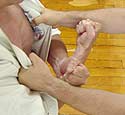
(3) In the kata the hands are usually closed, but in some old renditions the hands are open, and it is known that Itosu, the creator of the kata (modified from earlier versions known as Channan) closed the hands on many techniques practiced within the Pinan series. So opening the hands can be seen as a somewhat hidden application of the move. See the FightingArts.com articles: "Channan: The "Lost" Kata of Itosu?" and "Examining Yasutsune Itosu."
(4) Here Itosu, the creator of the kata, would have executed the kick with a straightened big toe. Toe kicks were a favorite of early Okinawan karate practitioners. Just as western ballet students learn to balance on their toes, Okinawan karate students trained from childhood to condition and build up strength in their big toes – often using exercises to stand up on them and use the toes to strike harder and harder targets. Itosu was famous for his "Low 9 Target Toe Kicks" (a subject of a future article), which students were drilled in repeatedly. In another old Okinawan foot techniques the toes were balled, much like the fingers are in a typical karate punch. This method had to be trained from early childhood since age quickly stiffens the toes and joints of the foot.
(5) The photo illustrating this hold and punch is not as pretty as the long, low stance and punch performed in the kata. Remember, however, that kata illustrates movement and direction. The length and depth of movement, however, often changes with circumstance. Also, what happens between the beginning and the end of a technique, is the most important. Most students, however, focus on the beginning and end positions of each kata move. Think how it would be if we tried to learn tennis by only looking at the start of the swing and the swing's finish. You wouldn't learn very much that way, but that is exactly what most people do when trying to understand kata.
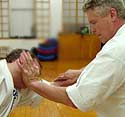

About the Author Christopher Caile

Screenshot
Christopher Caile is the Founder and Editor-In-Chief of FightingArts.com. He has been a student of the martial arts for over 65 years.
He first started in judo while in college. Then he added karate as a student of Phil Koeppel in 1959 studying Kempo and Wado-Ryu karate. He later added Shotokan Karate where he was promoted to brown belt and taught beginner classes. In 1960 while living in Finland, Caile introduced karate to that country and placed fourth in that nation's first national judo tournament.
Wanting to further his karate studies, Caile then hitch hiked from Finland to Japan traveling through Scandinavia, Europe, North Africa, the Middle East and South and Southeast Asia — living on 25 cents a day and often sleeping outside.
Arriving in Japan (1962), Caile was introduced to Mas Oyama and his fledgling full contact Kyokushinkai Karate by Donn Draeger, the famous martial artist and historian. Donn also housed him with several other senior international judo practitioners. Donn became Caile's martial arts mentor, coaching him in judo and introducing him to Shinto Muso-ryu under Takaji Shimizu.
Caile studied at Oyama's honbu dojo and also at Kenji Kurosaki's second Tokyo Kyokushinkai dojo. In his first day in class Oyama asked Caile to teach English to his chief instructor, Tadashi Nakamura. They have been friends ever since. Caile also participated in Oyama's masterwork book, "This Is Karate."
Caile left Japan with his black belt and designation as Branch Chief, the first in the US to have had extensive training in Japan directly under Oyama Sensei. As such, Oyama Sensei asked him to be his representative on visits to his US dojos to report on their status.
A little over a year later, Nakamura, Kusosaki and Akio Fujihira won an epic David vs. Goliath challenge match against Thailand's professional Muay Thai Boxers in Bangkok, Thailand, thrusting Kyolushinkai and Nakamura into national prominence.
Back in the US Caile taught Kyokushinkai karate in Peoria, Il while in college and later in Washington, DC. while in graduate school. Durimg this time Shihan Nakamura had moved to New York City to head Kyokushinkai's North American Operation.
In 1976 when Kaicho Tadashi Nakamura formed the World Seido Karate organization, Caile followed. Living then in Buffalo, NY, Caile taught Seido karate and self-defense at the State University of New York at Buffalo (SUNY Buffalo) for over 15 years where he also frequently lectured on martial arts and Zen in courses on Japanese culture.
Caile moved to New York City in 1999 to marry Jackie Veit. He is now an 8th degree black belt, Hanshi, training in Seido Karate's Westchester, NY Johshin Honzan (Spiritual Center) dojo. In Seido Caile is known for his teaching of and seminars on kata applications. He also produced a 14 segment video series on Pinan kata Bunkai currently available to Seido members.
Caile is also a long-time student and Shihan in Aikido. He studied in Buffalo, under Mike Hawley Shihan, and then under Wadokai Aikido's founder, the late Roy Suenaka (uchi deshi under Morihei Ueshiba, founder of Aikido and was Shihan under Tohei Sensei). In karate, Suenaka (8thdan) was also an in-house student of the Okinawan karate master Hohan Soken.
Having moved to New York City, Caile in 2000 founded this martial arts educational website, FightingArts.com. Twenty-five years later, in 2025, it underwent a major update and revision.
For FightingArts.com and other publications Caile wrote hundreds of articles on karate, martial arts, Japanese art, Chinese Medicine and edited a book on Zen. He also developed relationships with a cross section of leading martial arts teachers. Over the last four decades he has conducted extensive private research into karate and martial arts including private translations of the once secret Okinawan hand copied and passed on Kung Fu book, the Bubishi, as well as an early karate book by the karate master Kenwa Mabuni. He periodically returns to Japan and Okinawa to continue his studies and participate Seido karate events. In Tokyo he practiced (with Roy Suenaka Sensei) in a variety of aikido organizations with their founders – including private interviews and practices at the Aiki-kai Aikido Honbu dojo with the son and grandson of aikido's founder, Doshu (headmaster) Kisshomaru (an old uchi-deshi friend) and his son, Moriteru Ueshiba and in Iwama with Morihiro Saito. On Okinawa he studied Goju Ryu karate under Eiichi Miyazato, 10th dan founder of Naha's Jundokan, and also with Yoshitaka Taira (who later formed his own organization, who specialized in kata Bunkai. While there Caile also trained with Hohan Soken's senior student, Master Fusei Kise, 10 dan as well as with the grandson of the legendary karate master Anko Itosu.
Caile's other martial arts experience includes: Diato-ryu Aikijujitsu and Kenjitsu, kobudo, boxing, Muay Thai, MMA, Kali (empty hand, knife and bolo), study of old Okinawan Shoran-ryu & Tomari body mechanics, study of old Okinawan kata under Richard Kim, study of close quarter defense and combat, including knife and gun defenses, Kyusho Jitsu and several Chinese fighting arts including 8 Star Praying Mantis, Pak Mei (White Eyebrow), and a private family system of Kung Fu.
Caile is also a student of Zen as well as a long-term student of one branch of Traditional Chinese Medicine, Chi Kung (Qigong). As one of two senior disciples of Chi Kung master Dr. Shen (M.D., Ph.D.) Caile was certified to teach and practice. This led to Caile's founding of the The Chi Kung Healing Institute on Grand Island, NY. In Western NY, he also frequently held Chi Kung seminars, including at SUNY Buffalo and at the famous Chautauqua Institution in Chautauqua, NY. His articles on Chi Kung also appeared in the Holistic Health Journal and in several books on alternative medicine.
Caile holds a BA in International Studies from Bradley University and MA in International Relations with a specialty in South and Southeast Asia from American University in Washington, D.C. While in Buffalo, NY he also studied digital and analog electronics.
In his professional life Caile also worked in public relations and as a newspaper reporter and photographer. Earlier he worked in the field of telecommunications including Managing a Buffalo, NY sales and service branch for ITT. He then founded his own private telephone company. This was followed by creation of an electrical engineering company that designed and patented his concept for a new type of low-cost small business telephone system (which was eventually sold to Bell South). The company also did contract work for Kodak and the US space program. Simultaneously Caile designed and manufactured a unique break-apart portable pontoon boat.
Most recently Caile co-founded an internet software company. Its products include software suites with AI capability for control and management of streaming media, such as video and music, an all-in-one book publishing software product for hardcover, eBook and audio book creation and security software for buildings and government use.
For more details about Christopher Caile's martial arts, work experience and life profile, see the About section in the footer of this site.
Search for more articles by this author:
